VOLVO XC90 TWIN ENGINE 2019 Owners Manual
Manufacturer: VOLVO, Model Year: 2019, Model line: XC90 TWIN ENGINE, Model: VOLVO XC90 TWIN ENGINE 2019Pages: 697, PDF Size: 10.33 MB
Page 281 of 697
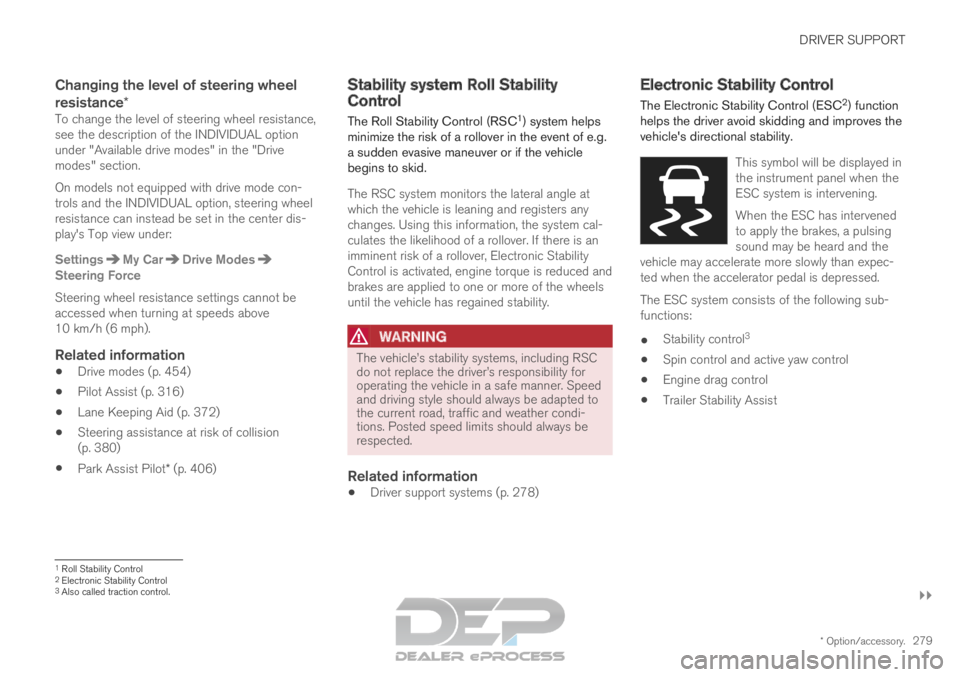
DRIVER SUPPORT
}}
* Option/accessory. 279
Changing the level of steering wheel
resistance*
To change the level of steering wheel resistance,
see the description of the INDIVIDUAL option
under "Available drive modes" in the "Drive
modes" section.
On models not equipped with drive mode con-
trols and the INDIVIDUAL option, steering wheel
resistance can instead be set in the center dis-
play's Top view under:
Settings My Car Drive Modes
Steering Force
Steering wheel resistance settings cannot be
accessed when turning at speeds above
10 km/h (6 mph).
Related information
Drive modes (p. 454)
Pilot Assist (p. 316)
Lane Keeping Aid (p. 372)
Steering assistance at risk of collision
(p. 380)
Park Assist Pilot* (p. 406) Stability system Roll Stability
Control
The Roll Stability Control (RSC 1
) system helps
minimize the risk of a rollover in the event of e.g.
a sudden evasive maneuver or if the vehicle
begins to skid.
The RSC system monitors the lateral angle at
which the vehicle is leaning and registers any
changes. Using this information, the system cal-
culates the likelihood of a rollover. If there is an
imminent risk of a rollover, Electronic Stability
Control is activated, engine torque is reduced and
brakes are applied to one or more of the wheels
until the vehicle has regained stability.
WARNING The vehicle
Page 282 of 697
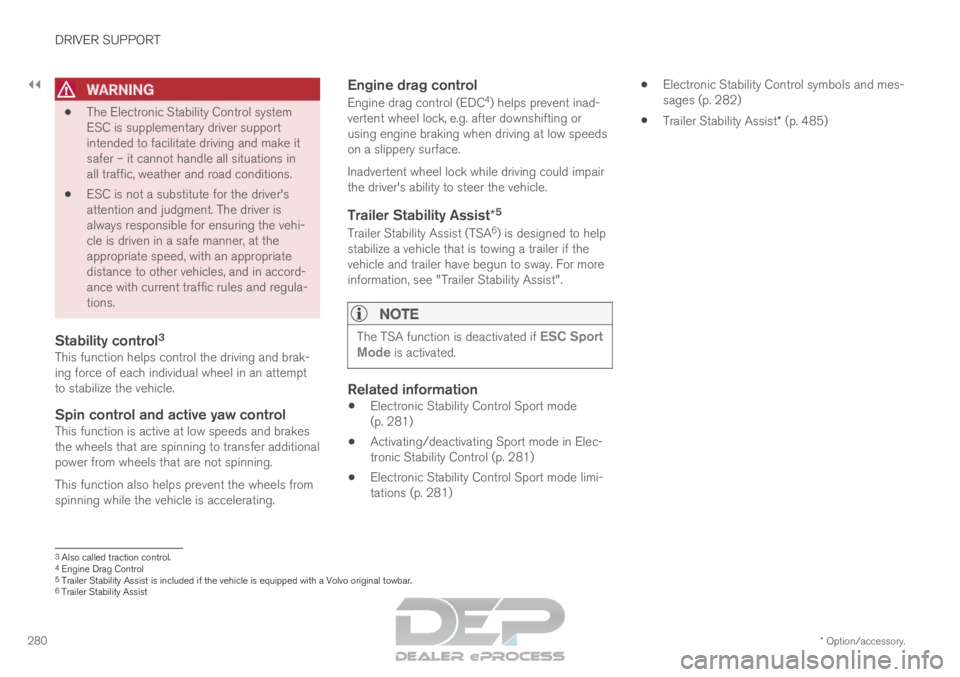
||DRIVER SUPPORT
* Option/accessory.
280
WARNING
The Electronic Stability Control system
ESC is supplementary driver support
intended to facilitate driving and make it
safer – it cannot handle all situations in
all traffic, weather and road conditions.
ESC is not a substitute for the driver's
attention and judgment. The driver is
always responsible for ensuring the vehi-
cle is driven in a safe manner, at the
appropriate speed, with an appropriate
distance to other vehicles, and in accord-
ance with current traffic rules and regula-
tions.
Stability control 3This function helps control the driving and brak-
ing force of each individual wheel in an attempt
to stabilize the vehicle.
Spin control and active yaw controlThis function is active at low speeds and brakes
the wheels that are spinning to transfer additional
power from wheels that are not spinning.
This function also helps prevent the wheels from
spinning while the vehicle is accelerating.
Engine drag control
Engine drag control (EDC
4
) helps prevent inad-
vertent wheel lock, e.g. after downshifting or
using engine braking when driving at low speeds
on a slippery surface.
Inadvertent wheel lock while driving could impair
the driver's ability to steer the vehicle.
Trailer Stability Assist* 5
Trailer Stability Assist (TSA
6
) is designed to help
stabilize a vehicle that is towing a trailer if the
vehicle and trailer have begun to sway. For more
information, see "Trailer Stability Assist".
NOTE The TSA function is deactivated if
ESC Sport
Mode is activated.
Related information
Electronic Stability Control Sport mode
(p. 281)
Activating/deactivating Sport mode in Elec-
tronic Stability Control (p. 281)
Electronic Stability Control Sport mode limi-
tations (p. 281)
Electronic Stability Control symbols and mes-
sages (p. 282)
Trailer Stability Assist* (p. 485)
3
Also called traction control.4 Engine Drag Control5Trailer Stability Assist is included if the vehicle is equipped with a V\
olvo original towbar.6 Trailer Stability Assist
Page 283 of 697
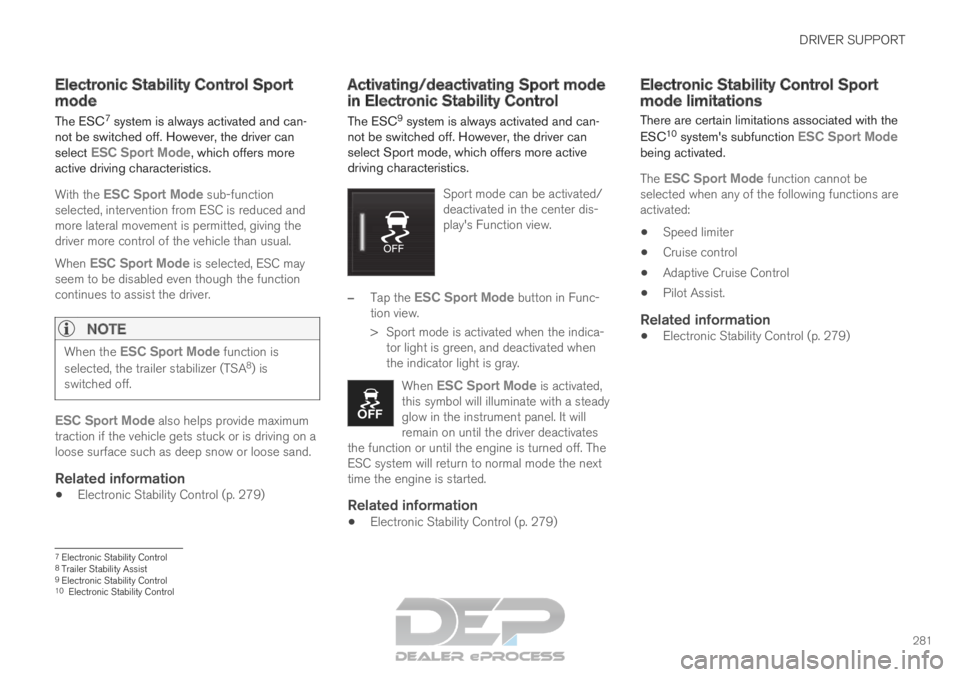
DRIVER SUPPORT
281
Electronic Stability Control Sport
mode
The ESC 7
system is always activated and can-
not be switched off. However, the driver can
select ESC Sport Mode, which offers more
active driving characteristics.
With the ESC Sport Mode sub-function
selected, intervention from ESC is reduced and
more lateral movement is permitted, giving the
driver more control of the vehicle than usual.
When ESC Sport Mode is selected, ESC may
seem to be disabled even though the function
continues to assist the driver.
NOTE When the ESC Sport Mode function is
selected, the trailer stabilizer (TSA 8
) is
switched off. ESC Sport Mode also helps provide maximum
traction if the vehicle gets stuck or is driving on a
loose surface such as deep snow or loose sand.
Related information
Electronic Stability Control (p. 279) Activating/deactivating Sport mode
in Electronic Stability Control
The ESC
9
system is always activated and can-
not be switched off. However, the driver can
select Sport mode, which offers more active
driving characteristics.
Sport mode can be activated/
deactivated in the center dis-
play's Function view. –
Tap the
ESC Sport Mode button in Func-
tion view.
>
Sport mode is activated when the indica-
tor light is green, and deactivated when
the indicator light is gray.
When ESC Sport Mode is activated,
this symbol will illuminate with a steady
glow in the instrument panel. It will
remain on until the driver deactivates
the function or until the engine is turned off. The
ESC system will return to normal mode the next
time the engine is started.
Related information
Electronic Stability Control (p. 279) Electronic Stability Control Sport
mode limitations
There are certain limitations associated with the
ESC 10
system's subfunction ESC Sport Mode
being activated.
The
ESC Sport Mode function cannot be
selected when any of the following functions are
activated:
Speed limiter
Cruise control
Adaptive Cruise Control
Pilot Assist.
Related information
Electronic Stability Control (p. 279) 7
Electronic Stability Control
8 Trailer Stability Assist
9 Electronic Stability Control
10 Electronic Stability Control
Page 284 of 697
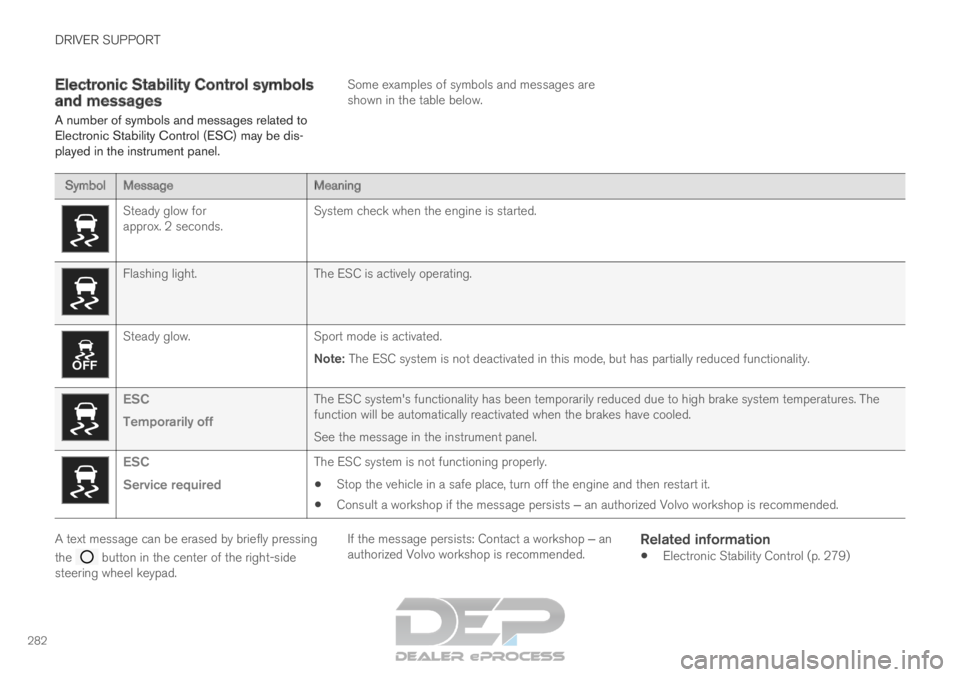
DRIVER SUPPORT
282Electronic Stability Control symbols
and messages
A number of symbols and messages related to
Electronic Stability Control (ESC) may be dis-
played in the instrument panel. Some examples of symbols and messages are
shown in the table below.Symbol
Message MeaningSteady glow for
approx. 2 seconds.
System check when the engine is started.Flashing light.
The ESC is actively operating.Steady glow.
Sport mode is activated.
Note: The ESC system is not deactivated in this mode, but has partially reduc\
ed functionality. ESC
Temporarily off
The ESC system's functionality has been temporarily reduced due to hi\
gh brake system temperatures. The
function will be automatically reactivated when the brakes have cooled.
See the message in the instrument panel.ESC
Service required
The ESC system is not functioning properly.
Stop the vehicle in a safe place, turn off the engine and then restart i\
t.
Consult a workshop if the message persists ‒ an authorized Volvo workshop is recommended. A text message can be erased by briefly pressing
the
button in the center of the right-side
steering wheel keypad. If the message persists: Contact a workshop ‒ an
authorized Volvo workshop is recommended.
Related information
Electronic Stability Control (p. 279)
Page 285 of 697
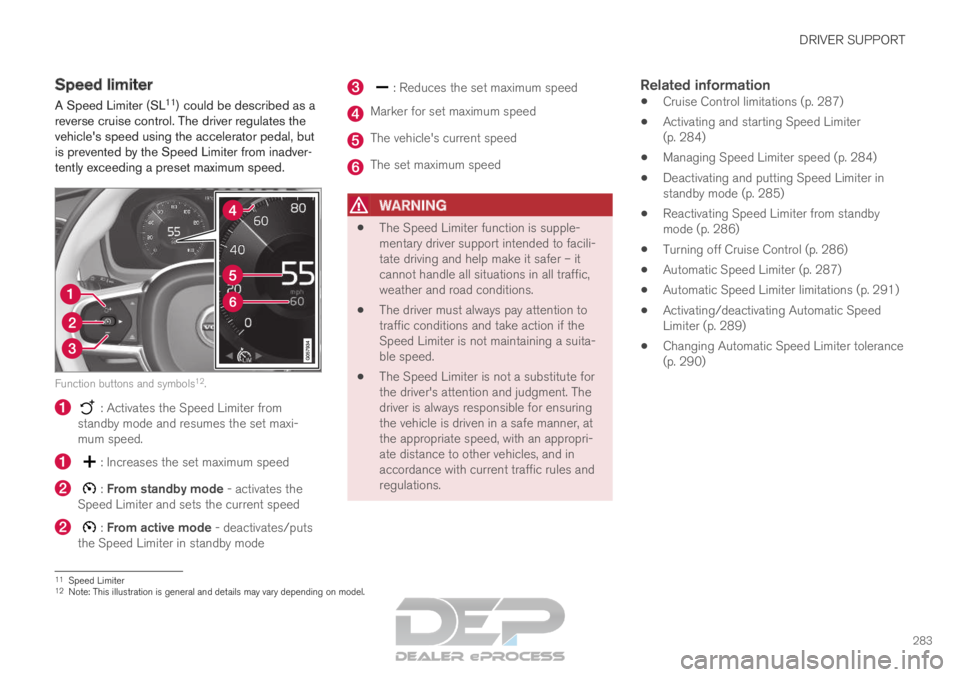
DRIVER SUPPORT
283
Speed limiter
A Speed Limiter (SL 11
) could be described as a
reverse cruise control. The driver regulates the
vehicle's speed using the accelerator pedal, but
is prevented by the Speed Limiter from inadver-
tently exceeding a preset maximum speed. Function buttons and symbols
12
. : Activates the Speed Limiter from
standby mode and resumes the set maxi-
mum speed. : Increases the set maximum speed
: From standby mode - activates the
Speed Limiter and sets the current speed : From active mode - deactivates/puts
the Speed Limiter in standby mode : Reduces the set maximum speed
Marker for set maximum speed
The vehicle's current speed
The set maximum speed
WARNING
The Speed Limiter function is supple-
mentary driver support intended to facili-
tate driving and help make it safer – it
cannot handle all situations in all traffic,
weather and road conditions.
The driver must always pay attention to
traffic conditions and take action if the
Speed Limiter is not maintaining a suita-
ble speed.
The Speed Limiter is not a substitute for
the driver's attention and judgment. The
driver is always responsible for ensuring
the vehicle is driven in a safe manner, at
the appropriate speed, with an appropri-
ate distance to other vehicles, and in
accordance with current traffic rules and
regulations.
Related information
Cruise Control limitations (p. 287)
Activating and starting Speed Limiter
(p. 284)
Managing Speed Limiter speed (p. 284)
Deactivating and putting Speed Limiter in
standby mode (p. 285)
Reactivating Speed Limiter from standby
mode (p. 286)
Turning off Cruise Control (p. 286)
Automatic Speed Limiter (p. 287)
Automatic Speed Limiter limitations (p. 291)
Activating/deactivating Automatic Speed
Limiter (p. 289)
Changing Automatic Speed Limiter tolerance
(p. 290) 11
Speed Limiter
12 Note: This illustration is general and details may vary depending on mod\
el.
Page 286 of 697
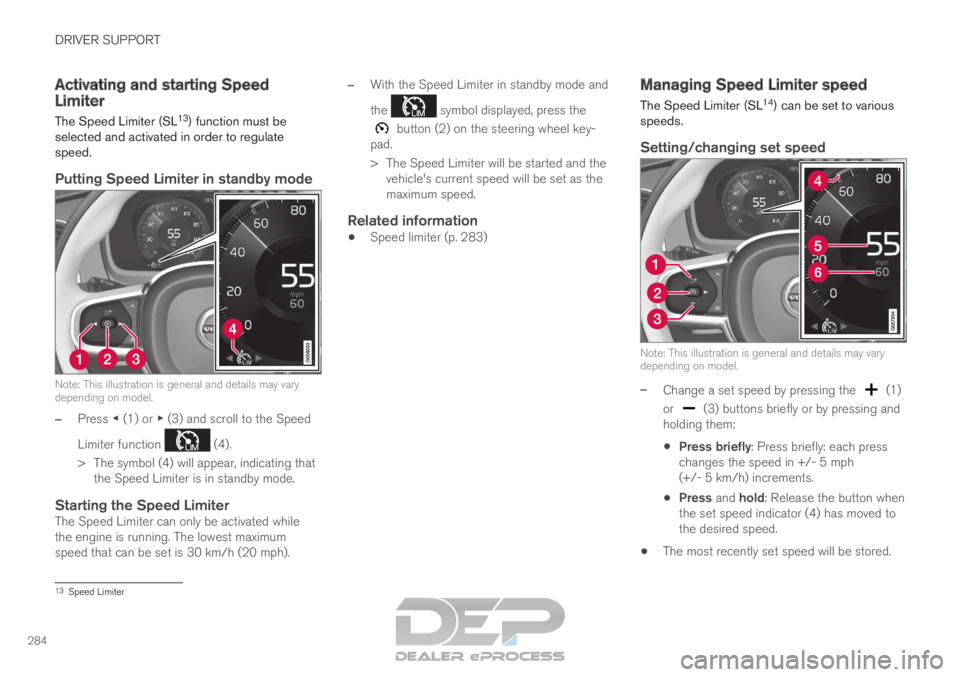
DRIVER SUPPORT
284Activating and starting Speed
Limiter
The Speed Limiter (SL 13
) function must be
selected and activated in order to regulate
speed.
Putting Speed Limiter in standby mode Note: This illustration is general and details may vary
depending on model.
–
Press ◀ (1) or ▶ (3) and scroll to the Speed
Limiter function (4).
>
The symbol (4) will appear, indicating that
the Speed Limiter is in standby mode.
Starting the Speed LimiterThe Speed Limiter can only be activated while
the engine is running. The lowest maximum
speed that can be set is 30 km/h (20 mph). –
With the Speed Limiter in standby mode and
the symbol displayed, press the
button (2) on the steering wheel key-
pad.
>
The Speed Limiter will be started and the
vehicle's current speed will be set as the
maximum speed.
Related information
Speed limiter (p. 283) Managing Speed Limiter speed
The Speed Limiter (SL
14
) can be set to various
speeds.
Setting/changing set speed Note: This illustration is general and details may vary
depending on model.
–
Change a set speed by pressing the (1)
or (3) buttons briefly or by pressing and
holding them:
Press briefly: Press briefly: each press
changes the speed in +/- 5 mph
(+/- 5 km/h) increments.
Press and hold: Release the button when
the set speed indicator (4) has moved to
the desired speed.
The most recently set speed will be stored. 13
Speed Limiter
Page 287 of 697
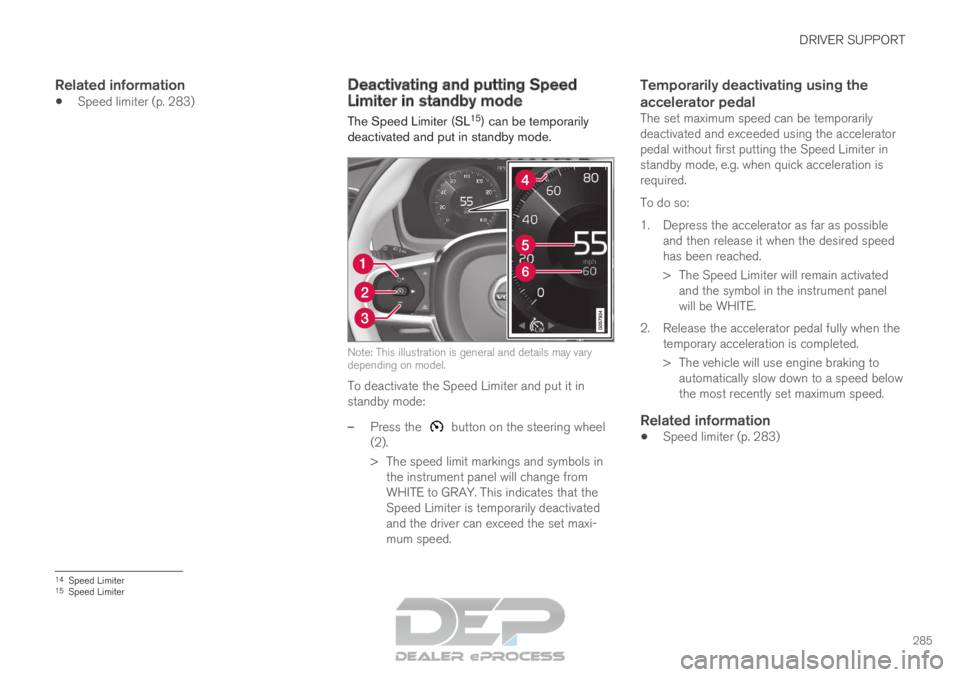
DRIVER SUPPORT
285
Related information
Speed limiter (p. 283) Deactivating and putting Speed
Limiter in standby mode
The Speed Limiter (SL 15
) can be temporarily
deactivated and put in standby mode. Note: This illustration is general and details may vary
depending on model.
To deactivate the Speed Limiter and put it in
standby mode:
–
Press the button on the steering wheel
(2).
>
The speed limit markings and symbols in
the instrument panel will change from
WHITE to GRAY. This indicates that the
Speed Limiter is temporarily deactivated
and the driver can exceed the set maxi-
mum speed.
Temporarily deactivating using the
accelerator pedal
The set maximum speed can be temporarily
deactivated and exceeded using the accelerator
pedal without first putting the Speed Limiter in
standby mode, e.g. when quick acceleration is
required.
To do so:
1. Depress the accelerator as far as possible and then release it when the desired speed
has been reached.
> The Speed Limiter will remain activatedand the symbol in the instrument panel
will be WHITE.
2. Release the accelerator pedal fully when the temporary acceleration is completed.
> The vehicle will use engine braking toautomatically slow down to a speed below
the most recently set maximum speed.
Related information
Speed limiter (p. 283) 14
Speed Limiter
15 Speed Limiter
Page 288 of 697
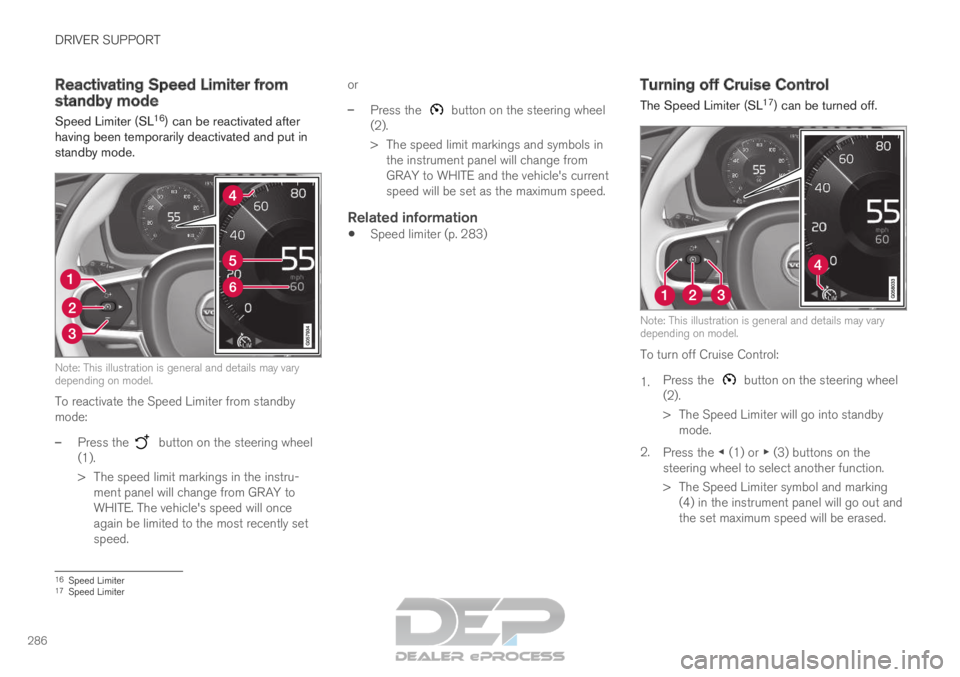
DRIVER SUPPORT
286Reactivating Speed Limiter from
standby mode
Speed Limiter (SL 16
) can be reactivated after
having been temporarily deactivated and put in
standby mode. Note: This illustration is general and details may vary
depending on model.
To reactivate the Speed Limiter from standby
mode:
–
Press the button on the steering wheel
(1).
>
The speed limit markings in the instru-
ment panel will change from GRAY to
WHITE. The vehicle's speed will once
again be limited to the most recently set
speed. or
– Press the button on the steering wheel
(2).
>
The speed limit markings and symbols in
the instrument panel will change from
GRAY to WHITE and the vehicle's current
speed will be set as the maximum speed.
Related information
Speed limiter (p. 283) Turning off Cruise Control
The Speed Limiter (SL 17
) can be turned off. Note: This illustration is general and details may vary
depending on model.
To turn off Cruise Control:
1.
Press the button on the steering wheel
(2).
>
The Speed Limiter will go into standby
mode.
2. Press the ◀ (1) or ▶ (3) buttons on the
steering wheel to select another function.
> The Speed Limiter symbol and marking (4) in the instrument panel will go out and
the set maximum speed will be erased. 16
Speed Limiter
17 Speed Limiter
Page 289 of 697
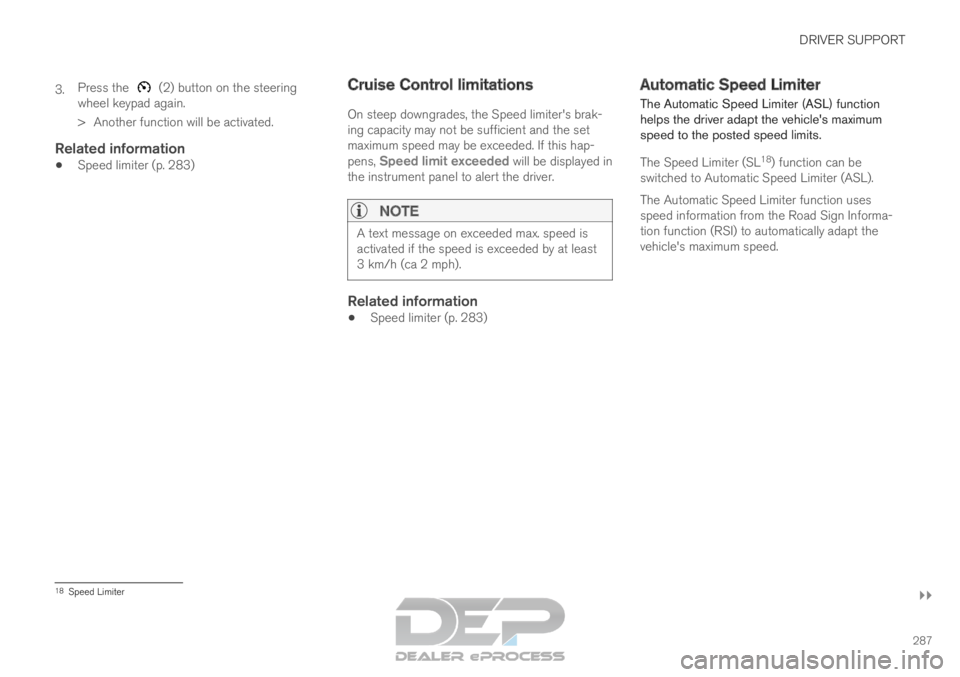
DRIVER SUPPORT
}}
287
3.
Press the (2) button on the steering
wheel keypad again.
>
Another function will be activated.
Related information
Speed limiter (p. 283) Cruise Control limitations
On steep downgrades, the Speed limiter's brak-
ing capacity may not be sufficient and the set
maximum speed may be exceeded. If this hap-
pens,
Speed limit exceeded will be displayed in
the instrument panel to alert the driver.
NOTE A text message on exceeded max. speed is
activated if the speed is exceeded by at least
3 km/h (ca 2 mph).
Related information
Speed limiter (p. 283) Automatic Speed Limiter
The Automatic Speed Limiter (ASL) function
helps the driver adapt the vehicle's maximum
speed to the posted speed limits.
The Speed Limiter (SL 18
) function can be
switched to Automatic Speed Limiter (ASL).
The Automatic Speed Limiter function uses
speed information from the Road Sign Informa-
tion function (RSI) to automatically adapt the
vehicle's maximum speed. 18
Speed Limiter
Page 290 of 697
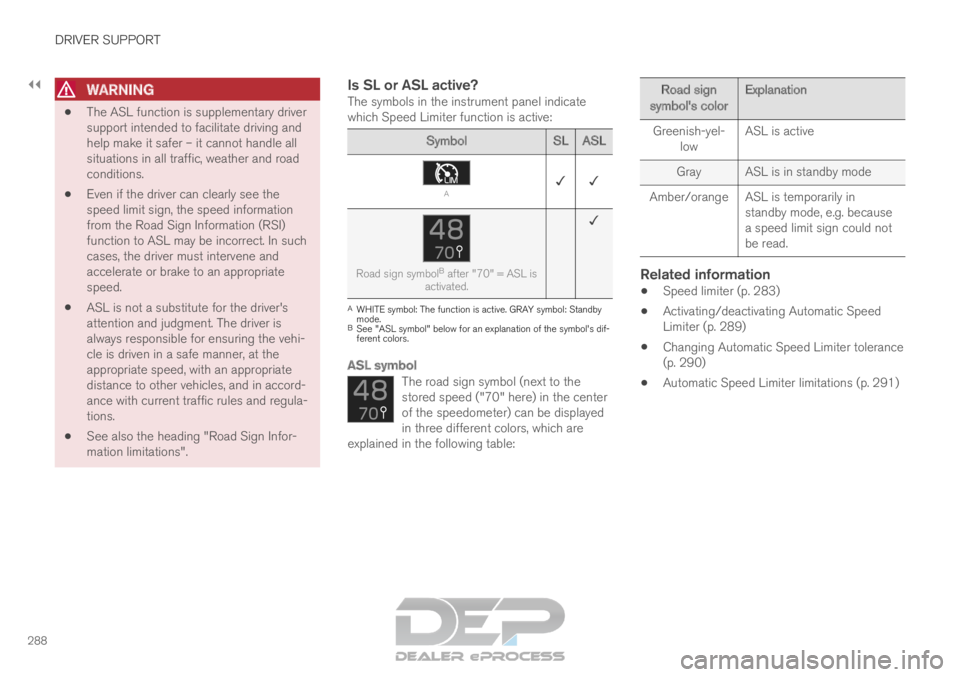
||DRIVER SUPPORT
288
WARNING
The ASL function is supplementary driver
support intended to facilitate driving and
help make it safer – it cannot handle all
situations in all traffic, weather and road
conditions.
Even if the driver can clearly see the
speed limit sign, the speed information
from the Road Sign Information (RSI)
function to ASL may be incorrect. In such
cases, the driver must intervene and
accelerate or brake to an appropriate
speed.
ASL is not a substitute for the driver's
attention and judgment. The driver is
always responsible for ensuring the vehi-
cle is driven in a safe manner, at the
appropriate speed, with an appropriate
distance to other vehicles, and in accord-
ance with current traffic rules and regula-
tions.
See also the heading "Road Sign Infor-
mation limitations".Is SL or ASL active?The symbols in the instrument panel indicate
which Speed Limiter function is active: Symbol
SLASL A
✓ ✓ Road sign symbol
B
after "70" = ASL is
activated. ✓ A
WHITE symbol: The function is active. GRAY symbol: Standby
mode.
B See "ASL symbol" below for an explanation of the symbol's dif-
ferent colors.
ASL symbol
The road sign symbol (next to the
stored speed ("70" here) in the center
of the speedometer) can be displayed
in three different colors, which are
explained in the following table: Road sign
symbol's color Explanation
Greenish-yel- low ASL is active
Gray
ASL is in standby mode
Amber/orange ASL is temporarily in standby mode, e.g. because
a speed limit sign could not
be read.
Related information
Speed limiter (p. 283)
Activating/deactivating Automatic Speed
Limiter (p. 289)
Changing Automatic Speed Limiter tolerance
(p. 290)
Automatic Speed Limiter limitations (p. 291)